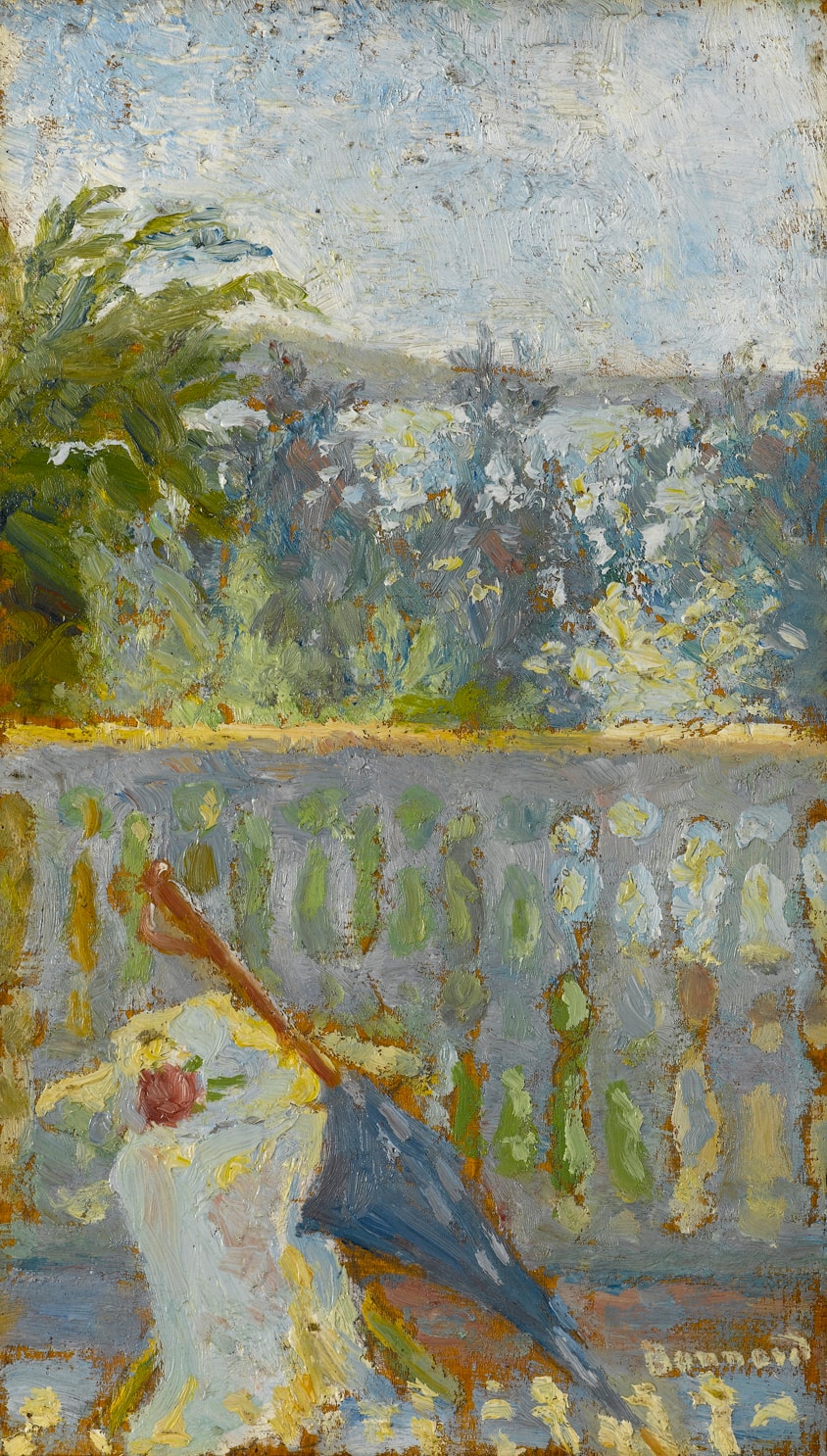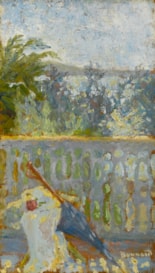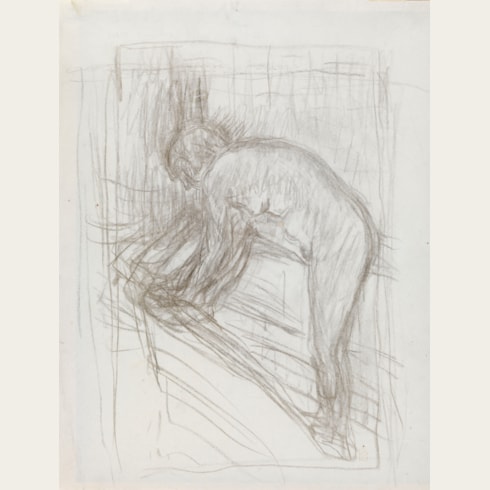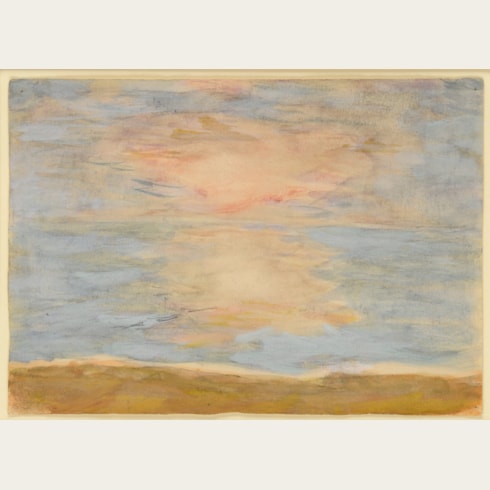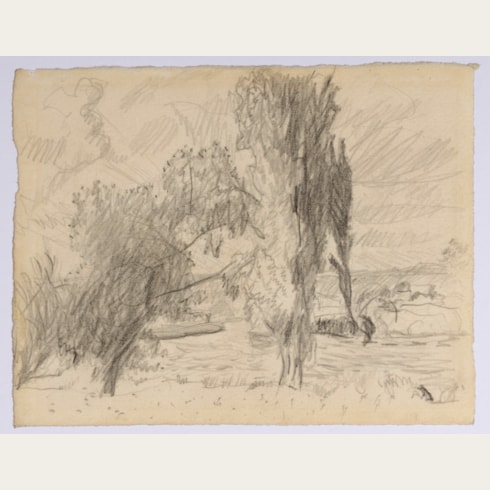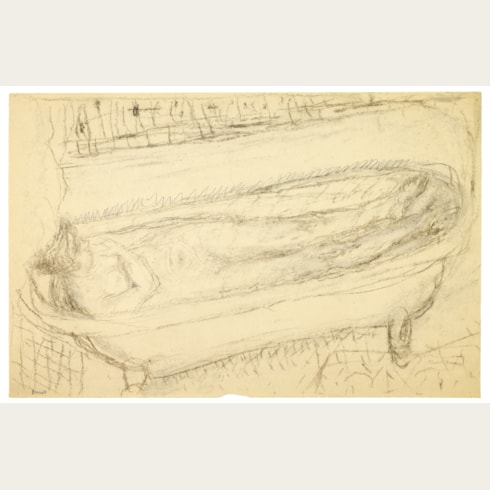Pierre BONNARD
(Fontenay-aux-Roses 1867 - Le Cannet 1947)
An Umbrella on a Balcony
Sold
Oil on panel.
Signed Bonnard at the lower right.
217 x 124 mm. (8 1/2 x 4 7/8 in.)
Signed Bonnard at the lower right.
217 x 124 mm. (8 1/2 x 4 7/8 in.)
This oil sketch, which would appear to depict a Mediterranean landscape, has been dated to c.1904. That year Pierre Bonnard made his first visit to the South of France. Together with Edouard Vuillard, he visited their fellow Nabis Ker-Xavier Roussel in Saint-Tropez, and also met Louis Valtat and Paul Signac. Captivated by the light and vegetation of the Midi, Bonnard returned to Saint-Tropez for a longer stay in the summer of 1909 as the guest of Henri Manguin. From then on he was to spend a large part of his career in the South, painting yearly on the Côte d’Azur; in Saint-Tropez, Antibes, Grasse and at Le Cannet, in the hills above Cannes, where he purchased a villa in 1925.
This small, charming composition is typical of Bonnard’s approach to painting after the turn of the century, when the artists of the Nabis group had begun to go their separate ways. Rejecting the radical approach to colour and method advocated by the Fauve and Cubist artists who made up the Parisian avant-garde in the early 20th century, Bonnard began to paint landscapes and interiors in what was ostensibly a more Impressionist manner. As has been noted of the artist, ‘Bonnard has often been classed as some kind of belated Impressionist. Certainly between 1900 and 1914 he came to adopt many of the hallmarks – the white ground, the broken and visible brush mark, and even the open-air subject matter – which had characterized Impressionism in its heyday...For Bonnard, Impressionism was a new starting point: ‘When my friends and I decided to pick up the research of the Impressionists, and attempt to take it further, we wanted to outshine them in their naturalistic impressions of colour. Art is not Nature. We were stricter in composition. There was a lot more to be got out of colour as a means of expression.’’
This painting is accompanied by a certificate from Guy-Patrice and Michel Dauberville, which notes that it is included in the Bonnard archives at the Galerie Bernheim-Jeune in Paris.
This small, charming composition is typical of Bonnard’s approach to painting after the turn of the century, when the artists of the Nabis group had begun to go their separate ways. Rejecting the radical approach to colour and method advocated by the Fauve and Cubist artists who made up the Parisian avant-garde in the early 20th century, Bonnard began to paint landscapes and interiors in what was ostensibly a more Impressionist manner. As has been noted of the artist, ‘Bonnard has often been classed as some kind of belated Impressionist. Certainly between 1900 and 1914 he came to adopt many of the hallmarks – the white ground, the broken and visible brush mark, and even the open-air subject matter – which had characterized Impressionism in its heyday...For Bonnard, Impressionism was a new starting point: ‘When my friends and I decided to pick up the research of the Impressionists, and attempt to take it further, we wanted to outshine them in their naturalistic impressions of colour. Art is not Nature. We were stricter in composition. There was a lot more to be got out of colour as a means of expression.’’
This painting is accompanied by a certificate from Guy-Patrice and Michel Dauberville, which notes that it is included in the Bonnard archives at the Galerie Bernheim-Jeune in Paris.
A compulsive draughtsman, Pierre Bonnard relied on his studies and sketches extensively in the preparation of his pictures. Most of his drawings seem to have been made in the process of developing the composition of a painting, and indeed he seems to have preferred to work from drawings rather than relying on direct observation. He made use of whatever paper came to hand, sometimes lined or squared pages of cheap paper or small sketchbooks, and generally of a small enough size to fit into his pocket. He almost always used a hard or soft pencil and only very rarely applied colour to his drawings, relying on the strength and shading of the pencil strokes to suggest tone and colour. In conversation with his nephew Charles Terrasse, Bonnard noted that ‘I am drawing incessantly - after drawing comes the composition which must have a perfect equilibrium, a well constructed picture is the battle half won, the art of composition is so powerful that with only black and white - a pencil, a pen or a lithographic pencil, one arrives at results as complete and of a quality nearly as beautiful as with a whole arsenal of colours.’
Bonnard rarely parted with his drawings, which were never intended to be exhibited or, indeed, regarded as independent works of art. Nevertheless, the artist’s work as a draughtsman is crucial to an understanding of his approach to painting. As Jack Flam has written, ‘Bonnard’s drawings are often very small, and as a result they are frequently overlooked in discussions of modern drawing. But their formal variety and sensitivity of touch are remarkable, as is the often fluctuant nature of their imagery. Although many of Bonnard’s drawings seem like shorthand notations of visual information recorded for later use in paintings, they are nonetheless effective as independent entities precisely because of the intensity of perception they incorporate. They also demonstrate an extraordinary sensitivity to the nature of the medium itself, unadorned by elaborate technical procedures.’
Provenance
Heinrich Thannhauser (Moderne Galerie), Munich
Acquired from him in the 1920’s by the Horndasch collection, Germany
Private collection, in the 1960’s
By descent to a private collection
Anonymous sale, London, Christie’s, 22 June 2011, lot 355
Private collection.

